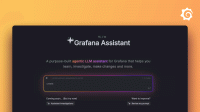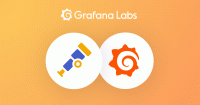Caution
Grafana Agent has reached End-of-Life (EOL) on November 1, 2025. Agent is no longer receiving vendor support and will no longer receive security or bug fixes. Current users of Agent Static mode, Agent Flow mode, and Agent Operator should proceed with migrating to Grafana Alloy. If you have already migrated to Alloy, no further action is required. Read more about why we recommend migrating to Grafana Alloy.
Important: This documentation is about an older version. It's relevant only to the release noted, many of the features and functions have been updated or replaced. Please view the current version.
Migrating from Grafana Agent Operator to Grafana Agent Flow
With the release of Grafana Agent Flow, Grafana Agent Operator is no longer the recommended way to deploy Grafana Agent in Kubernetes. Some of the Operator functionality has been moved into Grafana Agent Flow itself, and the remaining functionality has been replaced by our Helm Chart.
- The Monitor types (
PodMonitor,ServiceMonitor,Probe, andLogsInstance) are all supported natively by Grafana Agent Flow. You are no longer required to use the Operator to consume those CRDs for dynamic monitoring in your cluster. - The parts of the Operator that deploy the Grafana Agent itself (
GrafanaAgent,MetricsInstance, andLogsInstanceCRDs) are deprecated. We now recommend operator users use the Grafana Agent Helm Chart to deploy Grafana Agent directly to your clusters.
This guide will provide some steps to get started with Grafana Agent Flow for users coming from Grafana Agent Operator.
Deploy Grafana Agent Flow with Helm
You will need to create a
values.yamlfile, which contains options for deploying your Grafana Agent. You may start with the default values and customize as you see fit, or start with this snippet, which should be a good starting point for what the Operator does:agent: mode: 'flow' configMap: create: true clustering: enabled: true controller: type: 'statefulset' replicas: 2 crds: create: falseThis configuration will deploy Grafana Agent Flow as a
StatefulSetusing the built-in clustering functionality to allow distributing scrapes across all Grafana Agent Pods.This is not the only deployment mode possible. For example, you may want to use a
DaemonSetto collect host-level logs or metrics. See the Grafana Agent Flow deployment guide for more details about different topologies.Create a Grafana Agent configuration file,
agent.river.We will be adding to this configuration in the next step as we convert
MetricsInstances. You can add any additional configuration to this file as you desire.Install the Grafana Helm repository:
helm repo add grafana https://grafana.github.io/helm-charts helm repo updateCreate a Helm release. You may name the release anything you like. Here we are installing a release named
grafana-agent-metricsin themonitoringnamespace.helm upgrade grafana-agent-metrics grafana/grafana-agent -i -n monitoring -f values.yaml --set-file agent.configMap.content=agent.riverThis command uses the
--set-fileflag to pass the configuration file as a Helm value, so that we can continue to edit it as a regular River file.
Convert MetricsIntances to Grafana Agent Flow components
A MetricsInstance resource primarily defines:
- The remote endpoint(s) Grafana Agent Flow should send metrics to.
- Which
PodMonitor,ServiceMonitor, andProberesources this Grafana Agent should discover.
These functions can be done in Grafana Agent Flow with the prometheus.remote_write, prometheus.operator.podmonitors, prometheus.operator.servicemonitors, and prometheus.operator.probes components respectively.
This is a River sample that is equivalent to the MetricsInstance from our operator guide:
// read the credentials secret for remote_write authorization
remote.kubernetes.secret "credentials" {
namespace = "monitoring"
name = "primary-credentials-metrics"
}
prometheus.remote_write "primary" {
endpoint {
url = "https://PROMETHEUS_URL/api/v1/push"
basic_auth {
username = nonsensitive(remote.kubernetes.secret.credentials.data["username"])
password = remote.kubernetes.secret.credentials.data["password"]
}
}
}
prometheus.operator.podmonitors "primary" {
forward_to = [prometheus.remote_write.primary.receiver]
// leave out selector to find all podmonitors in the entire cluster
selector {
match_labels = {instance = "primary"}
}
}
prometheus.operator.servicemonitors "primary" {
forward_to = [prometheus.remote_write.primary.receiver]
// leave out selector to find all servicemonitors in the entire cluster
selector {
match_labels = {instance = "primary"}
}
}You will need to replace PROMETHEUS_URL with the actual endpoint you want to send metrics to.
This configuration will discover all PodMonitor, ServiceMonitor, and Probe resources in your cluster that match our label selector instance=primary. It will then scrape metrics from their targets and forward them to your remote write endpoint.
You may need to customize this configuration further if you use additional features in your MetricsInstance resources. Refer to the documentation for the relevant components for additional information:
- remote.kubernetes.secret
- prometheus.remote_write
- prometheus.operator.podmonitors
- prometheus.operator.servicemonitors
- prometheus.operator.probes
- prometheus.scrape
Collecting Logs
Our current recommendation is to create an additional DaemonSet deployment of Grafana Agents to scrape logs.
We have components that can scrape pod logs directly from the Kubernetes API without needing a DaemonSet deployment. These are still considered experimental, but if you would like to try them, see the documentation for loki.source.kubernetes and loki.source.podlogs.
These values are close to what the Operator currently deploys for logs:
agent:
mode: 'flow'
configMap:
create: true
clustering:
enabled: false
controller:
type: 'daemonset'
mounts:
# -- Mount /var/log from the host into the container for log collection.
varlog: trueThis command will install a release named grafana-agent-logs in the monitoring namespace:
helm upgrade grafana-agent-logs grafana/grafana-agent -i -n monitoring -f values-logs.yaml --set-file agent.configMap.content=agent-logs.riverThis simple configuration will scrape logs for every pod on each node:
// read the credentials secret for remote_write authorization
remote.kubernetes.secret "credentials" {
namespace = "monitoring"
name = "primary-credentials-logs"
}
discovery.kubernetes "pods" {
role = "pod"
// limit to pods on this node to reduce the amount we need to filter
selectors {
role = "pod"
field = "spec.nodeName=" + env("HOSTNAME")
}
}
discovery.relabel "pod_logs" {
targets = discovery.kubernetes.pods.targets
rule {
source_labels = ["__meta_kubernetes_namespace"]
target_label = "namespace"
}
rule {
source_labels = ["__meta_kubernetes_pod_name"]
target_label = "pod"
}
rule {
source_labels = ["__meta_kubernetes_pod_container_name"]
target_label = "container"
}
rule {
source_labels = ["__meta_kubernetes_namespace", "__meta_kubernetes_pod_name"]
separator = "/"
target_label = "job"
}
rule {
source_labels = ["__meta_kubernetes_pod_uid", "__meta_kubernetes_pod_container_name"]
separator = "/"
action = "replace"
replacement = "/var/log/pods/*$1/*.log"
target_label = "__path__"
}
}
local.file_match "pod_logs" {
path_targets = discovery.relabel.pod_logs.output
}
loki.source.file "pod_logs" {
targets = local.file_match.pod_logs.targets
forward_to = [loki.process.pod_logs.receiver]
}
// basic processing to parse the container format. You can add additional processing stages
// to match your application logs.
loki.process "pod_logs" {
stage.match {
selector = "{tmp_container_runtime=\"containerd\"}"
// the cri processing stage extracts the following k/v pairs: log, stream, time, flags
stage.cri {}
// Set the extract flags and stream values as labels
stage.labels {
values = {
flags = "",
stream = "",
}
}
}
// if the label tmp_container_runtime from above is docker parse using docker
stage.match {
selector = "{tmp_container_runtime=\"docker\"}"
// the docker processing stage extracts the following k/v pairs: log, stream, time
stage.docker {}
// Set the extract stream value as a label
stage.labels {
values = {
stream = "",
}
}
}
// drop the temporary container runtime label as it is no longer needed
stage.label_drop {
values = ["tmp_container_runtime"]
}
forward_to = [loki.write.loki.receiver]
}
loki.write "loki" {
endpoint {
url = "https://LOKI_URL/loki/api/v1/push"
basic_auth {
username = nonsensitive(remote.kubernetes.secret.credentials.data["username"])
password = remote.kubernetes.secret.credentials.data["password"]
}
}
}You will need to replace LOKI_URL with the actual endpoint of your Loki instance. The logging subsytem is very powerful
and has many options for processing logs. For further details see the component documentation.
Integrations
The Integration CRD is not supported with Grafana Agent Flow, however all static mode integrations have an equivalent component in the prometheus.exporter namespace. The reference docs should help convert those integrations to their Flow equivalent.



